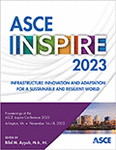Rapid Multi-Hazard Loss Estimation of Earthquake-Tsunami Impacts for Improved Disaster Response and Recovery
Publication: ASCE Inspire 2023
ABSTRACT
Megathrust subduction earthquakes, capable of triggering strong ground motions and tsunamis, significantly affect coastal infrastructure. Efficient disaster response and resource allocation require rapid and accurate assessments of economic consequences following such events. This study presents the development of a rapid multi-hazard loss estimation tool, utilizing simulated strong motion and offshore tsunami wave amplitude data to compensate for the scarcity of historical earthquake-tsunami data for calibration purposes. The research focuses on Japan’s Tohoku region, which has existing strong motion and tsunami monitoring networks. By adopting a multi-hazard catastrophe model and employing statistical methods, such as multiple linear regression and random forest regression, the study explores several predictive models for multi-hazard impact forecasting. The comparison of these models’ performances aids in identifying the most effective approach for rapid loss estimation. The findings contribute to improving immediate disaster response and recovery efforts, enabling better resource allocation and support for severely affected coastal communities.
Get full access to this article
View all available purchase options and get full access to this chapter.
REFERENCES
Breiman, L. (2001). Random Forests. Machine Learning, 45(1), 5–32. https://doi.org/10.1023/a:1010933404324.
De Risi, R., Goda, K., Yasuda, T., and Mori, N. (2017). Is flow velocity important in tsunami empirical fragility modeling? Earth-Science Reviews, 166, 64–82. https://doi.org/10.1016/j.earscirev.2016.12.015.
Gelman, A., and Hill, J. (2006). Data analysis using regression and multilevel/hierarchical models. Cambridge university press.
Goda, K. (2021). Multi-hazard parametric catastrophe bond trigger design for subduction earthquakes and tsunamis. Earthquake Spectra, 37(3), 1827–1848. https://doi.org/10.1177/8755293020981974.
Goda, K., and De Risi, R. (2018). Multi-hazard loss estimation for shaking and tsunami using stochastic rupture sources. International Journal of Disaster Risk Reduction, 28, 539–554. https://doi.org/10.1016/j.ijdrr.2018.01.002.
Goda, K., Franco, G., Song, J., and Radu, A. (2019). Parametric Catastrophe Bonds for Tsunamis: CAT-in-a-Box Trigger and Intensity-Based Index Trigger Methods. Earthquake Spectra, 35(1), 113–136. https://doi.org/10.1193/030918eqs052m.
Goda, K., Yasuda, T., Mori, N., and Maruyama, T. (2016). New Scaling Relationships of Earthquake Source Parameters for Stochastic Tsunami Simulation. Coastal Engineering Journal, 58(3), 1650010–1650040. https://doi.org/10.1142/s0578563416500108.
Goto, C. (1997). Numerical method of tsunami simulation with the leap-frog scheme. Intergovernmental Oceanographic Commission of UNESCO.
Hastie, T., Tibshirani, R., and Friedman, J. H. (2009). The elements of statistical learning: data mining, inference, and prediction. New York: springer.
Koshimura, S., Hayashi, S., and Gokon, H. (2014). The impact of the 2011 Tohoku earthquake tsunami disaster and implications to the reconstruction. Soils and Foundations, 54(4), 560–572. https://doi.org/10.1016/j.sandf.2014.06.002.
Li, Y., and Goda, K. (2022). Hazard and Risk-Based Tsunami Early Warning Algorithms for Ocean Bottom Sensor S-Net System in Tohoku, Japan, Using Sequential Multiple Linear Regression. Geosciences, 12(9), 350. https://doi.org/10.3390/geosciences12090350.
Midorikawa, S., Ito, Y., and Miura, H. (2011). Vulnerability Functions of Buildings based on Damage Survey Data of Earthquakes after the 1995 Kobe Earthquake. Journal of Japan Association for Earthquake Engineering. https://doi.org/10.5610/jaee.11.4_34.
Park, H., Alam, M. K., Cox, D. J., Fragiacomo, M., and Van De Lindt, J. W. (2019). Probabilistic seismic and tsunami damage analysis (PSTDA) of the Cascadia Subduction Zone applied to Seaside, Oregon. International Journal of Disaster Risk Reduction, 35, 101076. https://doi.org/10.1016/j.ijdrr.2019.101076.
Virtriana, R., Harto, A. B., Atmaja, F. W., Meilano, I., Fauzan, K. N., Anggraini, T. S., Ihsan, K. T. N., Mustika, F. A., and Suminar, W. (2022). Machine learning remote sensing using the random forest classifier to detect the building damage caused by the Anak Krakatau Volcano tsunami. Geomatics, Natural Hazards and Risk, 14(1), 28–51. https://doi.org/10.1080/19475705.2022.2147455.
Wu, H., Masaki, K., Irikura, K., and Kurahashi, S. (2016). Empirical Fragility Curves of Buildings in Northern Miyagi Prefecture During the 2011 off the Pacific Coast of Tohoku Earthquake. Journal of Disaster Research, 11(6), 1253–1270. https://doi.org/10.20965/jdr.2016.p1253.
Xie, Y., Sichani, M. E., Padgett, J. E., and DesRoches, R. (2020). The promise of implementing machine learning in earthquake engineering: A state-of-the-art review. Earthquake Spectra, 36(4), 1769–1801. https://doi.org/10.1177/8755293020919419.
Yamaguchi, N., and Yamazaki, F. (2001). Estimation of strong motion distribution in the 1995 Kobe earthquake based on building damage data. Earthquake Engineering & Structural Dynamics, 30(6), 787–801. https://doi.org/10.1002/eqe.33.
Information & Authors
Information
Published In
History
Published online: Nov 14, 2023
ASCE Technical Topics:
Authors
Metrics & Citations
Metrics
Citations
Download citation
If you have the appropriate software installed, you can download article citation data to the citation manager of your choice. Simply select your manager software from the list below and click Download.
